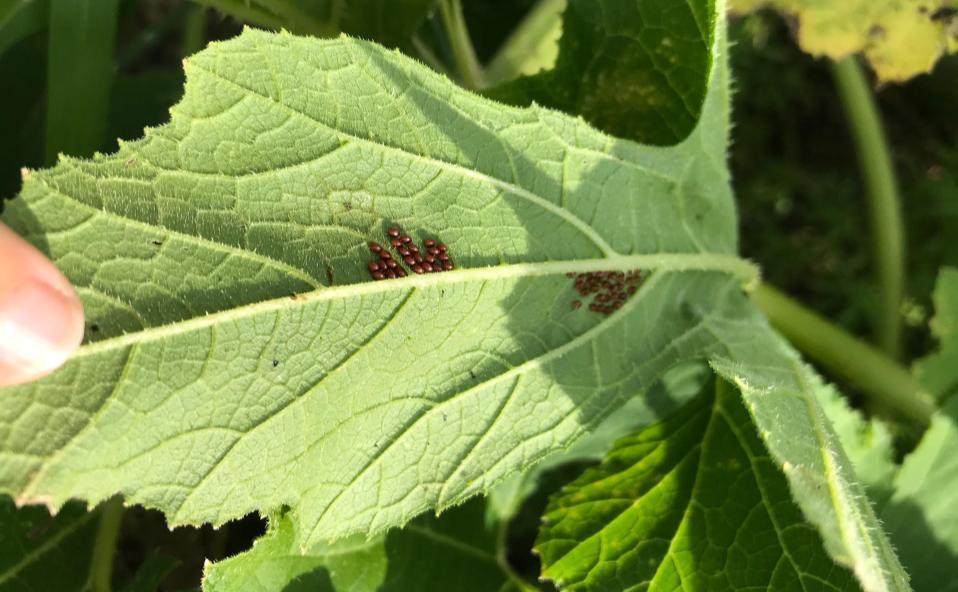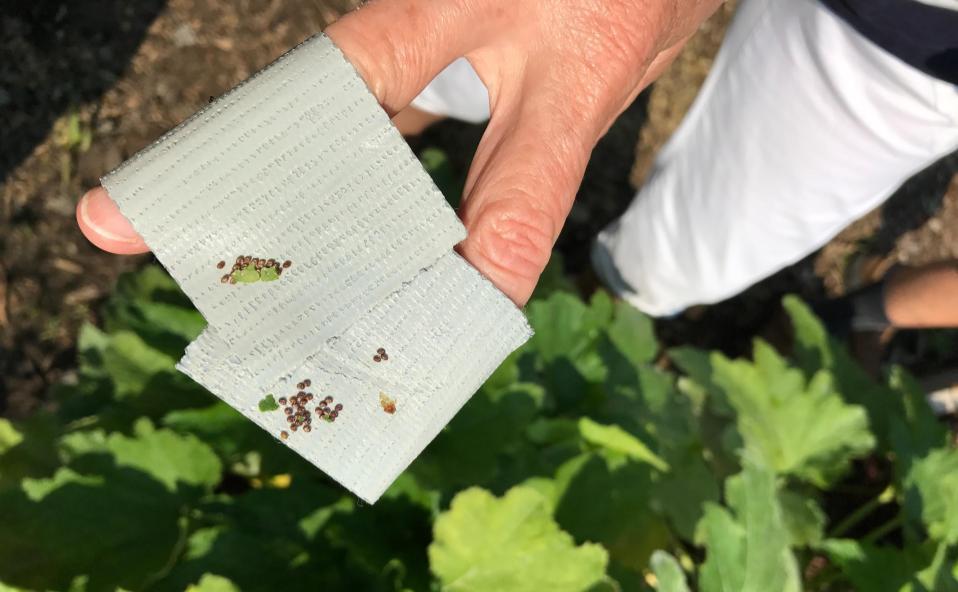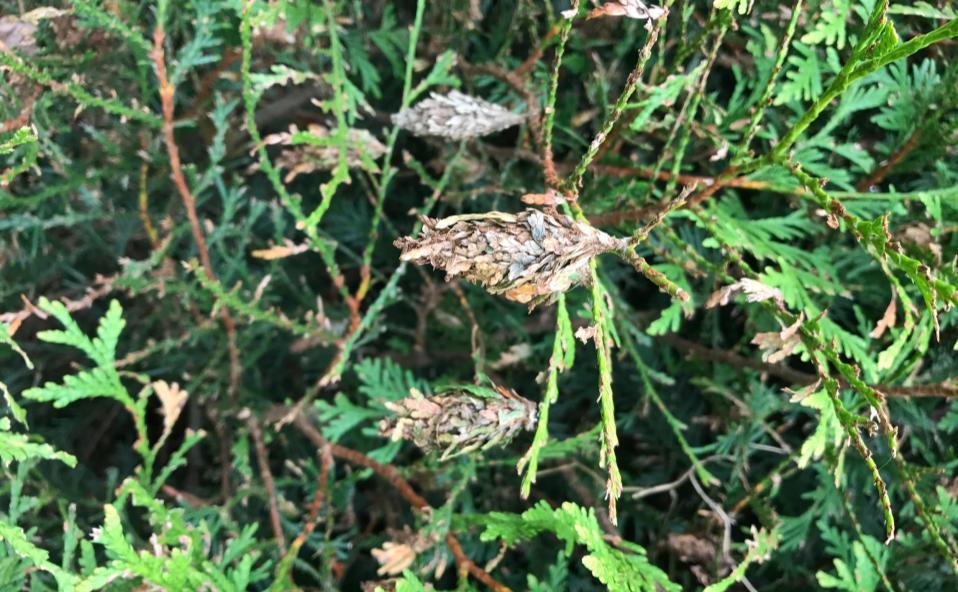The official start of summer is just a few weeks away. The first defense against plant problems is to follow healthy gardening practices. Here are some useful gardening tips for the month of June:

Squash bug eggs on the underside of squash leaf. Photo credit: Rachel Rhodes, Horticulture Educator
Outdoor Garden and Yard Tips
• Cut iris flower stalks down to the crown when they are finished blooming. Leave the foliage alone. If your iris are over-crowded after flowering lift and divide them. Check rhizomes for iris borer.
• Practice IPM (Integrated Pest Management) in your landscape. Do not spray your trees and shrubs preventively. This kills the predators and parasitoids that are helping to keep destructive pests under control.
• Water newly planted trees and shrubs until they become established (for about 2 years), especially in the summer and fall. Water deeply by allowing the water to soak into the soil directly underneath and around the root ball. Check the depth of water penetration into the soil by digging a small hole after watering. It should be moist about 6 inches down. A 2-3 inch layer of mulch is helpful. Keep mulch away from the trunk or stem.
• Apple scab and a number of rust diseases (cedar-apple, cedar-quince, cedar-hawthorn, Japanese apple, and pear trellis rust) are destructive diseases of crabapple in the landscape. They cause severe leaf defoliation by mid-summer if not treated. The best defense is replacing disease prone cultivars with resistant selections available at garden centers.

Squash bug eggs on duct tape. Photo credit: Rachel Rhodes, Horticulture Educator
Vegetable Garden
• Young tomato plants may be exhibiting symptoms of various leaf spot diseases such as septoria and early blight. Remove badly infected lower leaves, keep a thick organic mulch around plants and avoid overhead watering.
• Pinch off tomato suckers, to encourage larger, earlier fruit, especially if training to one central stem.
• “June drop” of excessive fruits (especially peaches) is a natural thinning phenomenon and is more pronounced where no hand thinning has occurred. Hand thin the fruits on plum, peach, apple and pear trees, leaving space (the width of one fruit) between remaining fruits. Disease and insect problems, environmental stress, and lack of pollination or fertilization can also cause fruit drop. Pick up and throw out all dropped fruits.
• Flea beetles are a serious pest of eggplant and also affect potato, tomato and members of the cabbage family. Floating row covers (https://youtu.be/oNm6D0KKG_Q) are an effective means of management but should be removed when plants flower to allow for cross-pollination by bumblebees. Spraying plants with “Surround” (kaolin clay) creates a white particle film that can minimize flea beetle feeding. You can also control flea beetles with “neem”, a botanical insecticide.
• Plant a second crop of beans.
• Keep watering and weeding; mulch new crops to keep them from drying out.
• Learn to identify beneficial insects and keep a vigilant eye out for possible pest infestations.
• Hand pick cabbage worms from broccoli and other members of the cabbage family, or spray with Bt (Bacillus thuringiensis), if necessary.
• Hand pick Colorado potato beetle adults, larvae and orange egg masses on potato and eggplant plants.
• Hand pick harlequin bugs and their black and white eggs from plants in the cabbage family. Do the same for Mexican bean beetles (yellow egg masses on leaf undersides).
• Prevent flea beetle infestations with row covers. Spray with pyrethrum or neem, both are derived from plants and considered low-risk organic controls. A light dusting of eggplant leaves with flour or wood ash can also deter flea beetles.
• Search the undersides of squash and pumpkin leaves for copper-colored squash bug eggs, and destroy them.
• For slug damage, in a wet period, set out tuna cans filled with beer or a brew of molasses, water and yeast. The slugs will crawl into them and drown. Boards and grapefruit rinds, turned face down, will also attract slugs; turn the board or rind over in the morning and destroy the slugs.

Bagworms. Photo credit: Rachel Rhodes, Horticulture Educator
Indoor Plants and Insect Tips
• Monitor houseplants kept indoors for mealybug, spider mites, aphids, whitefly, and scale. If houseplant pests are a problem consider spraying with a labeled horticultural oil or insecticidal soap. If possible, move the plants outside before spraying and when dry, move them back indoors. Discard heavily infested plants.
• Pantry pests, like Indian meal moths, grain beetles, cigarette beetles, and carpet beetles may be found around windows trying to get out of your home. These pests can be swept up or vacuumed. No chemical controls are recommended.
For further information, please visit https://extension.umd.edu/queen-annes-county/master-gardener-home-gardening or see us on Facebook @ https://www.facebook.com/QueenAnnesCountyMasterGardeners. For more information contact: Rachel J. Rhodes, Horticulture Educator and Master Gardener Coordinator for the University of Maryland Extension in Queen Anne’s County at (410) 758-0166 or by email at [email protected].
University of Maryland Extension programs are open to all people and will not discriminate against anyone because of race, age, sex, color, sexual orientation, physical or mental disability, religion, ancestry, or national origin, marital status, genetic information, or political affiliation, or gender identity and expression.
Don’t miss the latest! You can subscribe to The Talbot Spy‘s free Daily Intelligence Report here



Write a Letter to the Editor on this Article
We encourage readers to offer their point of view on this article by submitting the following form. Editing is sometimes necessary and is done at the discretion of the editorial staff.